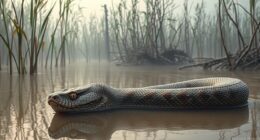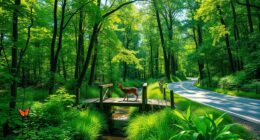As a wildlife conservationist, your day starts with reviewing reports and planning surveys to monitor species and habitats. You spend time in remote areas collecting data on ecosystem health, animal movements, and signs of habitat degradation. You collaborate with local communities and organizations to promote awareness and sustainable efforts. After fieldwork, you analyze your findings and update conservation plans. If you keep exploring, you’ll discover more about the dedication behind protecting our planet’s precious wildlife.
Key Takeaways
- Conduct field surveys to monitor species, assess habitat health, and detect threats like invasive plants or illegal activities.
- Analyze collected data to update conservation strategies and prepare reports supporting habitat preservation efforts.
- Collaborate with local communities, government agencies, and fellow conservationists through education and outreach activities.
- Use remote monitoring technology and portable gear to gather accurate data in remote or challenging environments.
- Reflect on daily impacts, stay motivated by conservation goals, and adapt strategies to improve long-term species survival.

Every day brings a new challenge and opportunity when you’re a wildlife conservationist. You wake up knowing that your work directly impacts the survival of endangered species and the health of their habitats. Your mornings often start with reviewing recent field reports, maps, and data to plan your day’s activities. Whether it’s monitoring a specific species or evaluating the condition of a protected area, your goal is to guarantee habitat preservation and support the recovery of vulnerable populations. You understand that every decision you make can determine whether an endangered species continues to thrive or faces further decline.
Each day as a wildlife conservationist is about protecting habitats and supporting endangered species’ recovery.
Today, you might head out to a remote patch of forest or grassland to conduct surveys. Your focus is on gathering essential information about the health of the ecosystem and the presence of species that need your help the most. You look for signs of habitat degradation, such as invasive plants or illegal logging, because these threats undermine efforts to protect endangered species. With a keen eye, you track animal movements, identify nesting sites, and record observations meticulously. These details are critical for creating effective conservation strategies and for informing local communities and policymakers. You know that habitat preservation isn’t just about protecting land—it’s about restoring the delicate balance that sustains diverse life forms. Incorporating remote monitoring technology can significantly enhance data collection in these challenging environments.
Throughout the day, you collaborate with local communities, government agencies, and fellow conservationists. Education and outreach play a key role in your work, as you explain how preserving habitats benefits everyone—locals, wildlife, and future generations. You might organize a workshop or lead a guided tour to raise awareness about the importance of safeguarding endangered species. You’re aware that community involvement often makes conservation efforts more sustainable and less vulnerable to political or economic pressures. Additionally, utilizing portable camping gear can help you conduct fieldwork more efficiently in remote locations, ensuring your work is both effective and comfortable. This equipment allows you to stay in the field longer and gather more comprehensive data, which is essential for successful habitat management. Moreover, understanding the importance of habitat preservation is fundamental for long-term conservation success.
Your work doesn’t end when you return to your office or campsite. Back at base, you analyze data, update conservation plans, and prepare reports. Every piece of information you compile helps strengthen habitat preservation initiatives and guides future actions. You also stay informed about conservation technology innovations that can improve data collection and monitoring efforts. You’re constantly adapting your approach based on new findings, always aiming to improve the chances of survival for endangered species. As the day winds down, you reflect on your impact, knowing that your dedication contributes to a broader effort to conserve wildlife and their habitats. It’s demanding work, but the possibility of making a real difference keeps you motivated, inspiring you to face each new challenge with resolve.
Frequently Asked Questions
What Inspired You to Become a Wildlife Conservationist?
You’re inspired by a passion for wildlife photography and a desire to promote environmental education. Seeing the beauty of nature through your lens fuels your commitment to protect endangered species and habitats. You believe that sharing powerful images and knowledge can inspire others to care about conservation efforts. Your drive comes from a love for the natural world and a sense of responsibility to guarantee its preservation for future generations.
How Do You Handle Dangerous Animal Encounters?
When you encounter dangerous animals, you rely on understanding their behavior and following strict safety protocols. You stay calm, avoid sudden movements, and maintain a safe distance. You also use protective gear and carry safety equipment. By observing animal behavior closely, you can anticipate their actions and react appropriately, ensuring both your safety and the animal’s well-being. Preparation and knowledge are your best tools in these risky situations.
What Is the Most Rewarding Part of Your Job?
You find the most rewarding part of your job in seeing the impact of habitat preservation and community engagement. Knowing you’re helping protect endangered species and their environments gives you a deep sense of fulfillment. When local communities become active participants in conservation efforts, it reinforces your purpose. Watching ecosystems thrive and knowing you’ve played a role in making that happen makes every challenging day worthwhile.
How Do You Fund Conservation Projects?
Think of funding conservation projects as tending a delicate garden—you need the right nourishment. You use donation strategies to attract support, crafting compelling stories that resonate. Grant writing is like planting seeds, requiring patience and precision to secure funding. By combining these methods, you guarantee your conservation efforts grow strong and sustainable, turning hope into action and safeguarding wildlife for generations to come.
What Are the Biggest Threats to Wildlife Today?
You face major threats to wildlife today, like habitat loss and poaching. Habitat loss from deforestation and urban development reduces living space for animals, making survival harder. Poaching, driven by illegal wildlife trade, kills many species each year. These threats endanger biodiversity and disrupt ecosystems. By understanding these dangers, you can support conservation efforts and help protect wildlife for future generations.
Conclusion
By the end of the day, you realize that every small effort counts—like when Sarah, a conservationist, successfully helped a group of orphaned elephants find their way back to the wild. Your dedication, whether tracking animals or educating locals, truly makes a difference. Remember, each day brings new challenges and rewards. Your passion fuels these essential efforts, ensuring that future generations can enjoy the beauty of wildlife just like you do today.








